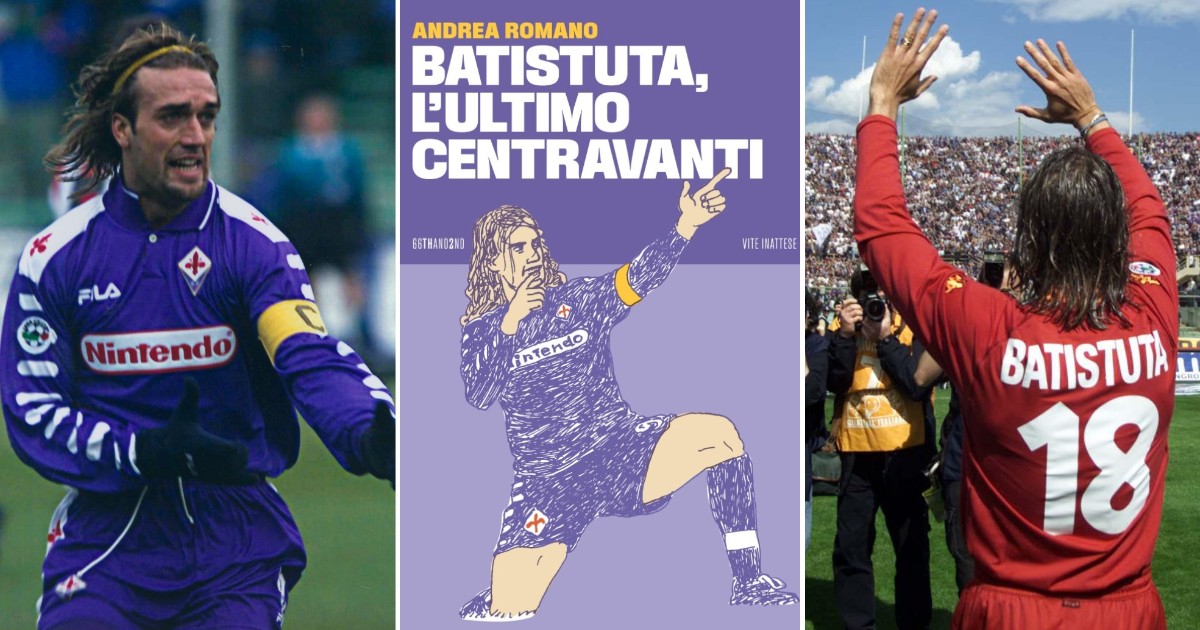That evening of November 26, 2000 I didn’t want to watch the match on TV. I was five years old and I couldn’t bear that my idol wore another shirt other than the purple one. “To one” for me was “Bati”. I had posters of her next to the bed, every time I got a ball at my feet I imagined myself with the long mane, the purple shirt and the grapeshot after bagging the ball into the goal. I had started cheering Fiorentina, very unconsciously, thanks to him and his exultation. So on 26 November 2000 I decided not to watch Roma-Fiorentina. It was the first game of Gabriel Omar Batistuta as an opponent of the purples. I turned off the light in my bedroom and went to bed. I didn’t want to know anything. Finally, many years later, I have only one vivid memory of that evening. My father entering the room as if to inform me of an emergency. Two sentences, broken voice, interrupted from a break. “We lost, Batistuta scored”. That goal, which launched Roma towards the third scudetto, I did not want to see it for many years. I only remember mine tearsa very long cry.
The same as Gabriel Omar that evening, after scoring without cheering. I found them in the beautiful book by Andrew Romano Batistuta, the last center forward just out for the necklace Unexpected lives Of 66THAND2D. A detail that had been forgotten. And instead the author brought it back to the surface. In that image of a great champion who scores by pushing his new team towards the final victory and at the same time he cries for having betrayed his adopted city, that is Florence, there is all of Batistuta. All his size and all his, perennial, restlessness. But also his desire to score goals, to always move the goal a little further at the cost of sacrificing his own ankles. And his sick love for Fiorentina and Florence which, we are in 1998, even goes so far as to spread poison on his alleged mistresses who would no longer make it on the pitch (all lies).
Contradictions, fragility and virtues of a champion that come to light in the book of journalist Roman. The author, also drawing from the drawer of memories, for over a year and a half studied the deeds of Bati by scanning videos, paperwork, newspaper clippings and biographies now unavailable on the market. He interviewed his former teammates (from Francesco Flachi a luis oliveira) but also his former coaches (from Fabio Capello a Claudio Ranieri) and her masseur Luciano Data who devised the machine gun by angering the then director of the Gazzetta dello Sport (“But will you stop? There is war in Kosovo“). Many masks and some supporting actors in Batistuta’s albeit short career – he stopped playing at the age of 36 with his ankles in pieces. A long journey that, as Romano says, will take him to the stadiums in Argentina del Newell’s al Bocaat Fiorentina, until the last few years divided between Rome, Inter and Al-Arabi to end his career. Without ever losing sight of the white shirt of her Argentina: top scorer with 56 goals, his record 10 goals in the finals of the World Cup it was only matched by Leo Messi in december into Qatar.
But Romano’s book focuses on the nine years with Fiorentina. A roundup of indelible memories in the minds of Viola fans. Seasoned above all with goals, celebrations and chants from the Fiesole. From the network with which “Bati” silenced the Camp Nou in the semi-final of the Cup Winners’ Cup (1997) to the razor with which he broke the door of Wembley against theArsenal (1999) up to the pearls against Juve and Milan and the victory in the final of Italian Cup with Atalanta. Many joys, but also many pains. For an up-and-down relationship with a fans – that of Florence – always very demanding and a president, Vittorio Cecchi Goriwho dreamed of doing as Berlusconi with Milan but without having the means. It was precisely the complicated menage a trois between the curve, Cecchi Gori and Batistuta that convinced the Argentine that it was better to change the scene (see under: Edmund). To go and win with another shirt. The eternal worry of Florence, which never manages to hold back its champions to the point of making them flags “alla Totti o alla Of the Piero”.
Yet, an exception was made with Batistuta. Despite the last years of his career away from Cupola by Brunelleschi, today in the city the Lion King is the most loved champion, the symbol of a team that is beautiful to look at but never really winning. Second only to the only 10, that is Giancarlo Antognoni, myth of a previous generation. It is no coincidence that Batistuta is the only Viola player to whom the Fiesole has dedicated two personalized choirs. One of the two goes like this: “I fall in love only if, I see Batistutaaa scoring … run to the flag, bomber of the Fiorentina!”. Every now and then he is dusted off by the purple curve, especially when “Bati” shows up at the Franks stadium. He dreams of returning, he said so, from executive. And Florence is ready to embrace it. Again.
